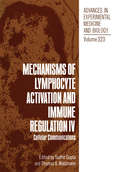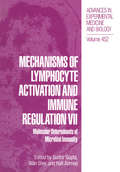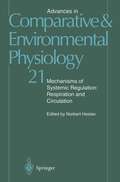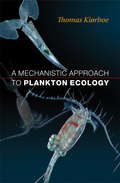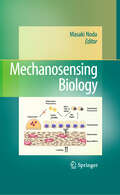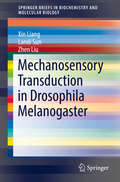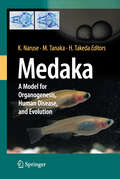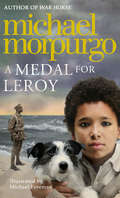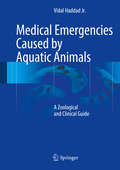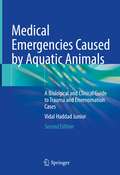- Table View
- List View
Mechanisms in the Pathogenesis of Enteric Diseases (Advances in Experimental Medicine and Biology #412)
by Prem S. Paul David H. Francis David A. BenfieldThis book, Mechanisms in the Pathogenesis of Enteric Diseases, is the outcome of the First International Rushmore Conference on Mechanisms in the Pathogenesis of En teric Diseases, held in September 1995 at Rapid City, South Dakota. The meeting was or ganized by members of the North-Central Regional Research Committee "NC-62," a United States Department of Agriculture-sponsored consortium of swine enteric disease researchers from land-grant institutions. This conference was conceived as a forum for an interdisciplinary discussion of mechanisms of infectious diseases. It was intended that such a discussion would stimulate cross-fostering of ideas and nurture synergistic collabo rations among scientists working on enteric diseases of humans and animals_. In atten dance, there were more than 140 participants from the United States and 12 foreign countries representing all of the world's continents. Participants brought expertise from many disciplines in both human and veterinary medicine. Multiple perspectives and an in formal atmosphere provided an environment for lively and thought-provoking discussions. Conference topics included Pathobiology of Gastroenteric Diseases, Mechanisms of Iden tity and Interaction between Host and Pathogen, Effector Mechanisms in the Pathogenesis of Enteric Diseases, Regulation of Pathogenic Activity in Enteric Diseases, and Novel Ap proaches to Prevention and Therapy of Enteric Diseases. Ten internationally renowned scientists gave keynote presentations in addition to 30 oral presentations and 39 poster presentations. The keynote speakers were Drs.
Mechanisms of Anesthetic Action in Skeletal, Cardiac, and Smooth Muscle (Advances in Experimental Medicine and Biology #301)
by Thomas J. J. Blanck David M. WheelerThe volatile anesthetics continue to be one of the most mysterious yet commonly used class of drugs in medical practice today. A prominent and troublesome side effect of volatile anesthetics is their ability to alter hemodynamics. This arises from two diverse but interrelated phenomena, depression of cardiac contractility and dilation of the vasculature. These effects of volatile anesthetics on cardiac and smooth muscle plus the action of volatile anesthetics on skeletal muscle in the malignant hyperthermic syndrome have led to concern about the interaction of volatile anesthetics (and other anesthetic agents) with calcium metabolism in the muscle cell. Many of the phenomena caused by anesthetics appear to have common mechanisms in all of the muscle types; however, the differences among skeletal, cardiac and smooth muscle also lead to distinct effects of the anesthetics in each. Given the diverse research disciplines which have been brought to hear on the mechanism of anesthetic alteration of contractility, the symposium from which this book originates was convened for the purpose of gathering those with common interests in anesthetic agents and their cellular and subcellular actions in muscle. The recent symposium had its origins in a small but exciting meeting that took place at the University of Texas at Houston in 1984. At that time, Robert Merin and Jacques Chelly convened a group of people who had interest in cardiac muscle and calcium antagonists.
Mechanisms of Carcinogenesis (Cancer Growth and Progression #2)
by Hans E. Kaiserbut also the possibility of intervention in specific stages. In Human behavior, including stress and other factors, plays an important role in neoplasia, although too little is known addition, variables which affect cancer development as well on the reasons for such development. Carcinogens, which as some endogenous factors can be better delineated help initiate the neoplastic process, may be either synthetic through such investigations. The topics of this volume encompass premalignant non or naturally-occurring. Cancer causation may be ascribed to invasive lesions, species-specific aspects of carcinogenicity, certain chemicals, physical agents, radioactive materials, viruses, parasites, the genetic make-up of the organism, and radiation, viruses, a quantum theory of carinogenesis, onco bacteria. Humans, eumetazoan animals and vascular plants genes, and selected environmental carcinogens. are susceptible to the first six groups of cancer causes, whe reas the last group, bacteria, seems to affect only vascular plants. Neoplastic development may begin with impairment ofJmdy defenses by a toxic material (carcinogen) which acts as an initiator, followed by promotion and progression to an overt neoplastic state. Investigation of these processes Series Editor Volume Editor allows not only a better insight into the mechanism of action Hans E. Kaiser Elizabeth K. Weisburger vii ACKNOWLEDGEMENT Inspiration and encouragement for this wide ranging project on cancer distribution and dissemination from a comparative biological and clinical point of view, was given by my late friend E. H. Krokowski.
Mechanisms of Gonadal Differentiation in Vertebrates: Contributions of an EMBO-Workshop held in Freiburg, November 5–8, 1982
by U. Müller W. FrankeMechanisms of Lymphocyte Activation and Immune Regulation III: Developmental Biology of Lymphocytes (Advances in Experimental Medicine and Biology #292)
by Sudhir Gupta William E. Paul Max D. Cooper Ellen RothenbergRecent advances in the understanding of the major events that shape the immune recog nition system have been remarkable. The analysis of immunoglobulin (Ig) gene organization and Ig repertoire diversification in lower vertebrates has provided new insight into this process in mammals. Similarly, the understanding of the early development of lymphocytes and of the acquisition of immunological tolerance has been aided by elegant studies in quail/chicken chimeras, using the power of the distinctive markers of the constitutive cells of these birds. Great strides have been made in understanding the role played by major histocompatibility complex (MHC) molecules in antigen presentation and in repertoire selec tion within the thymus. The use of transgenic mice expressing specific T-cell receptor (TCR) genes has elucidated the process of both positive and negative selection. In parallel, there has been considerable progress in our understanding of tolerance, based in part on the use of markers for the V fJ genes of T-cell receptors and in part on the analysis of the behavior of long term T-cell lines. This has led to the realization that both clonal deletion and clonal anergy may play critical roles in the maintenance of unresponsiveness to self antigen. Molecular analysis of the requirements for expression of membrane immunoglobulin molecules has revealed the existence of a complex that appears to be of critical importance in mediating signalling through Ig receptors. In addition, major insights have been obtained into the regulation of expression of genes of immunologic interest.
Mechanisms of Lymphocyte Activation and Immune Regulation IV: Cellular Communications (Advances in Experimental Medicine and Biology #323)
by Sudhir Gupta Thomas WaldmannIn recent years rapid progress has been made in the areas of T cell and B cell biology, cell-cell and cell-matrix/stroma interactions. The use of isolated subunits of the T cell receptor invariant chains has been instrumental in defining their role in signal transduction and tyrosine phosphorylation. A role of src family phosphotyrosine kinases in T cell activation has been demonstrated and several phosphotyrosine kinase substrates have been identified and their functions characterized. Homologous recombinant techniques have led to the development of murine strains that lack CD4 or CD8 expression. These models are likely to be instrumental in studying the role of T cell subsets in autoimmune disorders, tissue transplant rejection and tumor rejection. A role of major histocompatibility complex I in the development of T cell subsets and NK cells has been defined. Recent data suggest a role of interaction between plasma membrane molecules of activated T helper cells and B cells, B cells primed with plasma membrane of activated T helper cells and cytokines, and interaction between bone marrow stromal cells and B cell progenitors and precursors, in the B cell development, proliferation, and differentiation. The structure and functions of adhesion molecules, especially with regard to signal transduction and homing events, are better defined.
Mechanisms of Lymphocyte Activation and Immune Regulation V: Molecular Basis of Signal Transduction (Advances in Experimental Medicine and Biology #365)
by Sudhir Gupta William E. Paul Anthony DeFranco Roger PerlmutterSignaling through antigen receptor initiates a complex series of events resulting in the activation of genes that regulate the development, proliferation and differentiation of lymphocytes. During the past few years, rapid progress has been made in understanding the molecular basis of signaling pathways mediated by antigen and cytokine receptors. These pathways involve protein tyrosine kinases which are coupled to downstream regulatory molecules, including small guanine nucleotide binding proteins (e. g. p21'OS), serine threonine kinases (e. g. , members of the ERK family), and a large group of transcription factors. More recently, there have been breakthroughs in elucidating the genetic defects underlying three X-linked primary immunodeficiency diseases in humans. This volume surveys aspects of these rapidly developing areas of research. The book is divided into 5 different sections. Section I deals with signaling pathways in B lymphocytes. It includes a contemporary assessment of B cell antigen receptor structures, and discussion of the role of Ig-a/lg-B polypeptides in linking the antigen receptor to intracellular signal transduction pathways. The role of accessory molecules in the regulation of signaling by the B cell antigen receptor is also considered. Section II adopts a similar approach to the analysis of the antigen receptor on T lymphocytes. The importance of specialized signaling motifs in the CD3 polypeptides, mechanisms whereby these motifs may interact with the lymphocyte-specific protein tyrosine kinases, and the downstream consequences of these interactions are reviewed. In addition, the role of antigen-induced apoptosis in the generation of immunological tolerance is discussed.
Mechanisms of Lymphocyte Activation and Immune Regulation VI: Cell Cycle and Programmed Cell Death in the Immune System (Advances in Experimental Medicine and Biology #406)
by Sudhir Gupta J. John CohenSince programmed cell death was first described in insects in 1964 and apoptosis was described in 1972, rapid progress has been made in understanding the basic mechanisms and genes regulating programmed cell death and apoptosis. In addition, defects in various genes regulating programmed cell death have been delineated in several experimental models of human diseases. This volume surveys various aspects of these rapidly developing areas of research in programmed cell death/apoptosis. This volume should be of interest to basic immunologists and molecular biologists. The volume begins with a historical perspective of cell death. The remainder of the volume is divided into four different parts. Part I deals with the signaling pathways in apoptosis, including cell cycle control of apoptosis, role of ceramide in apoptosis, role of antibody signaling, and biochemical regulation of apoptosis. The mechanisms for recognition of apoptotic lymphocytes by macrophages are also reviewed. Part II examines the role of various genes that regulate apoptosis, including the role ofFas, FasL, and other TNF family members in apoptosis and homeostatic regulation of immune response. Recently described splice variants and their influence on apoptosis are also reviewed, and the role of the members of the Bcl-2 family in apoptosis is discussed in detail. Part III reviews various aspects of apoptosis in B lymphocytes, including mechanisms that regulate apoptosis/survival of B lymphocytes and the regulation of Fas-mediated apoptosis in B lymphocytes.
Mechanisms of Lymphocyte Activation and Immune Regulation VII: Molecular Determinants of Microbial Immunity (Advances in Experimental Medicine and Biology #452)
by RafiAhmed AlanSher SudhirGuptaProceedings of the Seventh International Conference held in New Port Beach, California, February 6-8, 1998
Mechanisms of Platelet Activation and Control (Advances in Experimental Medicine and Biology #344)
by Kalwant Authi Stephen Watson Vijay V. KakkarRecent years have seen tremendous advances in our understanding of the molecular mechanism of platelet activation. All aspects of signal transduction in platelets from the identification of surface receptors, G proteins, phospholipases, protein kinases and phosphatases, intracellular receptors for inositol phosphates, the Ca2+ regulatory machinery, cytoskeletal constituents to the control mechanism employing cyclic nucleotides has seen an explosion of information regarding their importance and for each constituent in the family of molecules to which they belong. This information has been of interest to researchers across a wide spectrum of disciplines including biochemists, pharmacologists, cell biologists and clinicians. In April 1992 an International Symposium bearing the name of this volume was organised at the Thrombosis Research Institute to bring together scientists from across the world whose common interest was the study of platelet activation and its regulation. We were particularly encouraged by the positive response from our speakers and the participants, their detailed contributions and the very lively discussions that took place throughout the two days of the symposium. Almost every aspect of signal transduction in human platelets was represented. Of the invited speakers twelve were from Europe (including the U. K. ), eight from North America and one from Japan. This volume is a compilation of chapters submitted by the speakers and represents a concise but informative picture of the present knowledge of the mechanisms of platelet activation and control.
Mechanisms of Systemic Regulation: Respiration and Circulation (Advances in Comparative and Environmental Physiology #21)
by Norbert Heisler G. Boutilier W. W. Burggren M. E. Feder N. Heisler J. W. Hicks A. Ishimatsu G. K. Iwama G. M. Malvin W. K. Milsom M. Nikinmaa S. Nilsson B. Pelster D. J. Randall P. Scheid D. P. Toews L. A. Wentzell A. L. ValMechanisms of Systemic Regulation: Acid—Base Regulation, Ion-Transfer and Metabolism (Advances in Comparative and Environmental Physiology #22)
by D. E. Atkinson E. Bourke W. H. Dantzler D. H. Evans M. K. Grieshaber B. J. Harvey N. Heisler P. Laurent S. F. Perry H. O. Pörtner T. J. Shuttleworth V. Urbach S. Völkel S. C. WoodMechanisms of Woody Plant Defenses Against Insects: Search for Pattern
by William J. Mattson Jean Levieux C. Bernard-DaganA Mechanistic Approach to Plankton Ecology
by Thomas KiørboeThe three main missions of any organism--growing, reproducing, and surviving--depend on encounters with food and mates, and on avoiding encounters with predators. Through natural selection, the behavior and ecology of plankton organisms have evolved to optimize these tasks. This book offers a mechanistic approach to the study of ocean ecology by exploring biological interactions in plankton at the individual level. The book focuses on encounter mechanisms, since the pace of life in the ocean intimately relates to the rate at which encounters happen. Thomas Kiørboe examines the life and interactions of plankton organisms with the larger aim of understanding marine pelagic food webs. He looks at plankton ecology and behavior in the context of the organisms' immediate physical and chemical habitats. He shows that the nutrient uptake, feeding rates, motility patterns, signal transmissions, and perception of plankton are all constrained by nonintuitive interactions between organism biology and small-scale physical and chemical characteristics of the three-dimensional fluid environment. Most of the book's chapters consist of a theoretical introduction followed by examples of how the theory might be applied to real-world problems. In the final chapters, mechanistic insights of individual-level processes help to describe broader population dynamics and pelagic food web structure and function.
Mechanistic Approaches to Interactions of Electric and Electromagnetic Fields with Living Systems
by Martin Blank E. FindlAlthough there is general agreement that exogenous electric and electromagnetic fields influence and modulate the properties of biological systems. there is no concensus regarding the mechanisms by which such fields operate. It is the purpose of this volume to bring together and examine critically the mechanistic models and concepts that have been proposed. We have chosen to arrange the papers in terms of the level of biological organization emphasized by the contributors. Some papers overlap categories. but the progression from ions and membrane surfaces. through macromolecules and the membrane matrix to integrated systems. establishes a mechanistic chain of causality that links the basic interactions in the relatively well understood simple systems to the complex living systems. where all effects occur simultaneously. The backgrounds of the invited contributors include biochemistry. biophysics. cell biology. electrical engineering. electrochemistry. electrophysiology. medicine and physical chemistry. As a result of this diversity. the mechanistic models reflect the differing approaches used by these disciplines to explain the same phenomena. Areas of agreement define the common ground. while the areas of divergence provide opportunities for refining our ideas through further experimentation. To facilitate the interaction between the different points of view, the authors have clearly indicated those published observations that they are trying to explain. i.e. the experiments that have been critical in their thinking. This should establish a concensus regarding important observations. In the discussion of theories.
The Mechanistic Benefits of Microbial Symbionts (Advances in Environmental Microbiology #2)
by Christon J. HurstThis volume summarizes recent advances in our understanding of the mechanisms that produce successful symbiotic partnerships involving microorganisms. It begins with a basic introduction to the nature of and mechanistic benefits derived from symbiotic associations. Taking that background knowledge as the starting point, the next sections include chapters that examine representative examples of coevolutionary associations that have developed between species of microbes, as well as associations between microbes and plants. The authors conclude with a section covering a broad range of associations between microbes and invertebrate animals, in which they discuss the spectrum of hosts, with examples ranging from bryozoans and corals to nematodes, arthropods, and cephalopods. Join the authors on this journey of understanding!
Mechanosensing Biology
by Masaki NodaMechanical stress is vital to the functioning of the body, especially for tissues such as bone, muscle, heart, and vessels. It is well known that astronauts and bedridden patients suffer muscle and bone loss from lack of use. Even the heart, in pumping blood, causes mechanical stress to itself and to vascular tissue. With the loss of mechanical stress, homeostasis becomes impaired and leads to pathological conditions such as osteopenia, muscle atrophy, and vascular tissue dysfunction. In elderly populations, such mechanical pathophysiology, as well as the mechanical activities of locomotor and cardiovascular systems, is important because skeletal and heart functions decline and cause diseases in other organs. In this monograph, mechanical stress is discussed by experts in the field with respect to molecular, cellular, and tissue aspects in relation to medicine. Covering topics such as gravity and tissues and disuse osteoporosis, the book provides the most up-to-date information on cutting-edge advancements in the field of mechanobiology and is a timely contribution to research into locomotor and circulatory diseases that are major problems in contemporary society.
Mechanosensitive Ion Channels (Mechanosensitivity in Cells and Tissues #1)
by I. LozinskyThis book explores the latest data dealing with mechanosensitive channels research results. It was compiled by a group of internationally recognized scientists leading in the field of mechanosensitive ion channels or mechanically gated channels and signaling cascades research. Key problems of cell mechanobiology are also discussed. As a whole, the volume dwells on the major issues of mechanical stress influencing the ion channels and intracellular signaling pathways.
The Mechanosensory Lateral Line: Neurobiology and Evolution
by Sheryl Coombs Peter Görner Heinrich MünzThis volume represents the published proceedings of an international conference on the Neurobiology and Evolution of the Mechanosensory Lateral Line System held August 31 to September 4, 1987, at the Center for Interdisciplinary Research at the University of Bielefeld, West Germany. The goal of this confer ence was to bring together researchers from all over the world to share informa tion about a major aquatic sensory system, the evolution and function of which have largely remained an enigma since the 18th century. The "lateral line" or "lateralis" system has been used as an umbrella term to describe what originally (without the aid of modern anatomical techniques) looked like a series of pits, grooves, and lines on the head and trunk of fishes and some amphibians. For at least the past 30 years, however, it has been recognized that the lateralis system comprises not one, but at least two functional classes of receptors: mechanoreceptors and electroreceptors. The relative ease with which the appropriate stimulus could be defined and measured for the electroreceptive class has resulted in an explosion of information on this submodality during the past 20 years. As a result, there is little ambiguity about the overall function of the electrosensory system, now generally regarded as an independent system in its own right. A similarly clear definition for the function of the mechanosensory lateralis system has not been as forthcoming.
Mechanosensory Transduction in Drosophila Melanogaster (SpringerBriefs in Biochemistry and Molecular Biology)
by Xin Liang Landi Sun Zhen LiuThis book offers an essential introduction for all graduate students and researchers who are working on or interested in mechanotransduction using fruit flies as their model organisms. Designed for accessibility, it follows a simple five-chapter structure, beginning with a general introduction to mechanotransduction in physiology (Chapter 1) and some basic considerations on the principles behind mechanotransduction processes (Chapter 2). In turn, Chapters 3, 4 and 5 focus on mechanoreceptors in Drosophila melanogaster. Chapter 3 explains how the fly’s mechanosensitive cells (i.e. mechanoreceptors) contribute to its daily life, while Chapter 4 explores the ultrastructural and mechanical basis for the working mechanisms of various fly mechanoreceptors. Lastly, Chapter 5 elaborates on the structure, function and physiology of mechanosensitive molecules in fly mechanoreceptors. Accordingly, the book provides an overall framework, helping readers understand mechanosensory transduction, from the physiological level to the molecular level.
Medaka: A Model for Organogenesis, Human Disease, and Evolution
by Kiyoshi Naruse, Minoru Tanaka and Hiroyuki TakedaOryzias latipes, known as medaka, is a model organism from East Asia. Breeding of this small, egg-laying freshwater teleost fish has long been popular among hobbyists in Japan. Now, as biological science has entered the genome era, the medaka provides significant advantages that make it one of the most valuable vertebrate models: a large collection of spontaneous mutants collected over a century, the presence of highly polymorphic inbred lines established over decades, and a recently completed genome sequence. This book is the first comprehensive monograph to cover a variety of medaka research. It opens with a historical view of medaka, followed by a series of research topics in the four major areas where the medaka is increasingly important: genomics, genetics, and resources; organogenesis and disease models; germ cells, sex determination, and reproduction; and evolution. Readers will find state-of-the-art information on medaka genetics and genomics such as the first isolation of active transposons in vertebrates, the influence of chromatin structure on sequence variation, fine QTL analysis, and versatile mutants as human disease models.
A Medal for Leroy
by Michael MorpurgoInspired by the true story of Walter Tull, the first black officer in the British army, this is a stunning new novel of identity and loss by Michael Morpurgo, biggest UK children’s author and the bestselling, award-winning writer of War Horse, now a smash West End and Broadway hit as well as an Oscar-nominated movie.
Medical Emergencies Caused by Aquatic Animals: A Zoological and Clinical Guide
by Vidal Haddad JrThe present book is intended as a reference guide for emergency and ambulatory care medicine, providing essential information on the most important problems and incidents caused by venomous, poisoning and traumatic marine and freshwater animals. Indeed, though emergencies caused by aquatic animals are becoming increasingly common, there are few reference books devoted to providing medical guidance on them. The book includes a wealth of original images of injuries caused by aquatic animals, while the text covers the current state knowledge on the subject, including the identification of the animals, the clinical aspects of the envenomation/poisonings/injuries, first aid and emergency care, main treatment alternatives and a typical case representing each group of animals. Chapters are organized according to zoological groups: Marine and Freshwater Invertebrates (Porifera, Cnidarians, Annelida, Mollusks, Echinodermata) and Marine and Freshwater Vertebrates (Fish and Reptiles). Medical Emergencies Caused By Aquatic Animals: A Zoological and Clinical Guide is intended for students and professionals in Medicine (Dermatology, Tropical Medicine, Infectious Diseases and Emergency Medicine) and the Biological Sciences (Zoology and Ecology), as well as to practicing professionals working in coastal or freshwater areas.
Medical Emergencies Caused by Aquatic Animals: A Biological and Clinical Guide to Trauma and Envenomation Cases
by Vidal Haddad JuniorThis is the second edition of the book originally published under the title Medical Emergencies Caused by Aquatic Animals: A Zoological and Clinical Guide. Including updated chapters, new content and additional references, it discusses follow-up with patients, describes diseases that are not emergencies and explains procedures that can take place at health stations and outpatient centers, focusing on clinical and biological aspects relevant to researchers and practitioners alike. The chapter on Invertebrate Aquatic Animals presents facts and advances that were left out of the first edition. In addition, it includes improved images. The subtopic on Cnidaria presents recent data on outbreaks and new species identification in unprecedented areas, with a timely discussion on first aid treatment. The chapter on Injuries by Vertebrate Aquatic Animals has been improved, based on continued work with bathers and fishermen. Featuring numerous images and representative clinical cases, it explores the most significant injuries caused by fish around the globe. The chapter on Ingestion of Aquatic Venomous Animals: Toxinology, Clinical Aspects, and Treatment discusses outbreaks of intoxication diseases from eating fish and seafood, drawing on reliable records of serial cases of Haff's syndrome, scombroidism and ciguatera. Further, it examines the indiscriminate consumption of aquatic animals, which the author argues present the same (or even greater) risks of poisoning and infections as terrestrial animals. Lastly, since there is a general lack of awareness of the risk of infections in aquatic environments, the chapter on Bacterial and Fungal Infections in Aquatic Environments describes the symptoms and treatments and highlights preventive measures.





